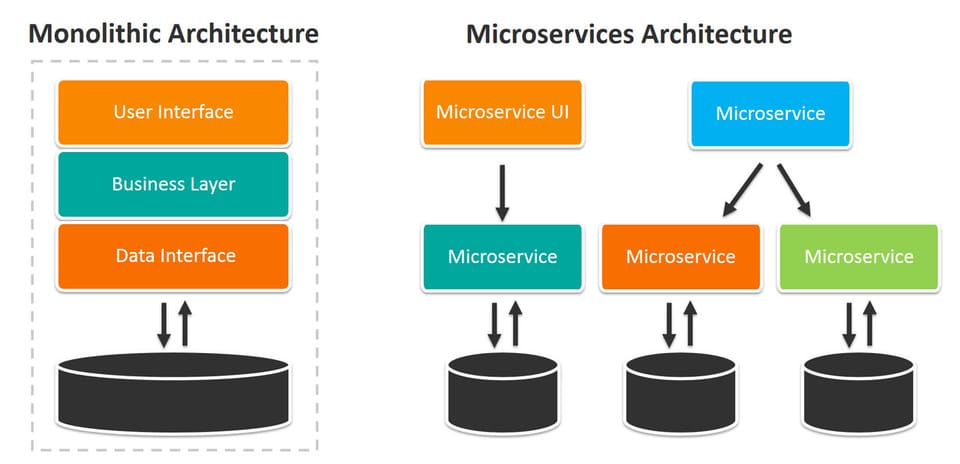Microservices vs Monoliths - Why Some Big Companies Are Making the Move Back to Monoliths
 Sakshi from KushoAI
Sakshi from KushoAI
In recent times, microservices architecture has been the go-to for building scalable, flexible applications. Big companies, particularly those with highly complex systems, switched to microservices to break down monolithic applications into smaller, independent services. However, some big companies are reconsidering this approach and switching back to monolithic architecture.
In this article, we will explore why this shift is happening and compare microservices with monolith architecture.
What are Microservice and Monolith architectures?
Before jumping into why these companies are switching back to Monolith architecture, let’s explore these two architectures.
Monolith Architecture
Monolithic architecture is a standard architecture in which all the application components are built in a single code base. Developers must develop and deploy the application in a single CI/CD pipeline; only a single tech stack is used/followed in the entire project. If you are building the application using Javascript, the backend and the frontend will also be built using Javascript only.
For example, if you are building an eCommerce website with different functionalities like add-to-cart, payment gateway, search, and more, you must do this in a single repository where all the application's source code is present.
Advantages of Monoliths:
Below are some of the advantages of Monolithic architecture:
Simplicity: A single codebase is easier to understand, manage, and deploy. It also simplifies the development workflow.
Better Performance for Certain Use Cases: Since all components exist inside one application/repository, collaboration is much easier, resulting in better performance, especially for certain use cases.
Simplified Testing and Deployment: With only one codebase, testing and deployment become much easier and less error-prone.
Reduced Complexity for Smaller Teams: Monoliths' simplicity can be a major advantage for smaller development teams or organizations, allowing faster development.
Microservice Architecture
In microservice architecture, we break down all the components into smaller services, which become individual services independent of each other. This allows you to change one part or service without affecting the application's other components. These smaller microservices will have independent development and a separate code base and can be independently deployed. As all the services are loosely coupled, many programming languages can also be used.
Microservices: Advantages and Challenges
Advantages
Microservices offer several key benefits that make them the go-to architecture for many organizations:
Scalability: Each service can be scaled independently, allowing teams to allocate resources to the system's most needed areas.
Flexibility: Microservices allow developers to use different technologies and languages for different services, ensuring that each service can be built appropriately.
Agility in Development: Teams can work on different services in parallel, making it easier to develop and deploy new features quickly and easily.
Challenges
Despite the advantages, microservices have many challenges:
Increased Complexity: Managing numerous independent services can lead to complexity in deployment and communication.
Difficulties in Debugging and Testing: Debugging issues in a microservice-based architecture are more difficult due to the various points of failure. Testing microservices often requires extensive setup for integration testing.
Costly Infrastructure: Running and maintaining multiple independent services and separate databases drastically increases the infrastructure costs.
Monolithic Architecture: Why It’s Making a Comeback
Why Companies Are Moving Back:
MNCs like Uber and Twitter have recently partially reverted to the monolithic architecture. Here are some of the reasons why:
High Maintenance Costs: Managing and maintaining a large microservices architecture requires significant resources. As companies scale, the overhead of maintaining hundreds of services becomes unsustainable.
Over-Engineering: Many companies adopted microservices when there wasn't a need, leading to over-engineered solutions for problems that a simple monolithic approach could easily and efficiently handle.
Inefficiency: The complexity of microservices architecture can lead to more troubles, such as inefficiency, slower development, and higher operational costs.
Advantages of Using Monolith over Microservices
We explored why companies are moving back from Microservice to Monolith in the above. Here are some examples for using Monolith Architecture over Microservices
Simplified Deployment: With only one codebase to deploy, the deployment process becomes much smoother and faster.
Reduced Learning Curve: Developers no longer need to become familiar with multiple independent services, resulting in a reduced learning curve.
Faster Integration and Builds: Having everything in one place minimizes integration issues, and build times can decrease significantly.
Simplified Testing: Testing becomes easier since fewer integration points exist, and end-to-end testing is more straightforward and easy.
Reduced Complexity: Fewer moving parts mean fewer things that can go wrong, leading to a smoother QA process.
Conclusion
We have reached the end of the article. In it, we learned about Monolith and Microservice architecture, their advantages and disadvantages, and why some big companies prefer monolith over microservice and are making this transition.
While microservices architecture still holds strong advantages, the trend of some big companies moving back to monolithic systems shows the importance of choosing the right architecture for their needs. Monoliths offer simplicity, better performance, and reduced complexity, making it an attractive option for certain organizations, especially those struggling with the overhead of microservices at scale.
This blog was written by Akshat Virmani at KushoAI. We're building an AI agent that tests your APIs for you. Bring in API information and watch KushoAI turn it into fully functional and exhaustive test suites in minutes.
Subscribe to my newsletter
Read articles from Sakshi from KushoAI directly inside your inbox. Subscribe to the newsletter, and don't miss out.
Written by